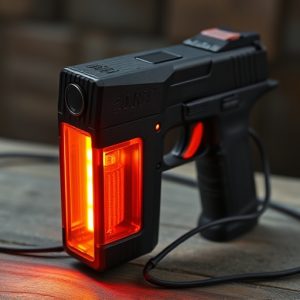Decoding Runt Stun Gun Voltage: Safety, Mechanisms, and Legal Use
The "runt" stun gun is a compact yet effective self-defense device that, despite its lowe…….
The "runt" stun gun is a compact yet effective self-defense device that, despite its lower voltage range of 450,000 to over 1,000,000 volts, is a reliable tool for incapacitating an attacker through muscle contractions. Its effectiveness is not solely dependent on voltage but also on high amperage, advanced electrode configurations, and multi-mode functionalities that enhance its stopping power in various self-defense situations. Users must understand the device's electrical mechanisms and ensure proper training to handle it safely. Legality varies by jurisdiction, with some regions allowing civilians to own stun guns like the runt, while others restrict them to authorized personnel. It's essential for potential owners to research and comply with local laws and regulations. Proper maintenance, including regular inspections, cleaning, and adherence to charging recommendations, is vital to ensure the stun gun functions correctly when needed.
When it comes to personal safety devices, understanding the electrical output of a runt stun gun is paramount. This article demystifies the voltage behind these compact self-defense tools, guiding readers through their mechanisms, performance metrics, and legal frameworks governing their use. We’ll explore how a runt stun gun’s voltage affects its capacity and effectiveness, ensuring you have the knowledge to operate one safely and maintain it for optimal performance. Join us as we navigate the intricacies of these devices, empowering you with the facts you need to know.
Understanding Runt Stun Gun Voltage: The Basics and Safety Considerations
When examining the performance of a runt stun gun, one must consider its voltage as a primary metric. A stun gun’s voltage is a critical factor determining its effectiveness in incapacitating an assailant. Typically, stun guns are designed to deliver an electric shock that can range from 450,000 volts down to much lower voltages. The term “runt” here refers to models with a voltage output at the lower end of this spectrum. Despite being labeled as “runt,” these devices are still potent and should be handled with caution and respect for their capabilities.
Understanding the voltage of a runt stun gun is essential for users to grasp its potential impact. A stun gun’s voltage influences the intensity of the electric shock it delivers. Higher voltages can penetrate further into muscle tissue, causing more significant discomfort or involuntary muscle contractions. However, even with lower voltage outputs, runt stun guns are designed to be effective in self-defense situations. Safety considerations are paramount when dealing with any stun gun; this includes proper training on how to use the device correctly and ensuring that it is used only as a last resort for self-defense. It’s also crucial to store the stun gun safely to prevent accidental discharges, which could lead to unintended harm. Users should always be aware of their surroundings and local laws regarding the carry and use of stun guns before considering one for personal protection.
The Mechanisms Behind a Runt Stun Gun's Electrical Output
A runt stun gun, despite its compact size, operates on the principles of electrical capacity and voltage to deliver a disabling shock. The device harnesses a high-voltage charge stored in its internal capacitor. When activated, this charge is released through the conductive probes in a rapid but controlled manner. The voltage surge is not the highest among stun gun models; hence, it’s often referred to as “runt” due to its lower voltage compared to other units. However, the electrical output is not solely determined by voltage alone; the current and duration of the shock also play critical roles. The runt stun gun generates a high-amperage surge that can quickly incapacitate an attacker by overloading their muscular system. This disruptive electrical signal overwhelms the body’s neural messages, causing muscle spasms and temporary paralysis, effectively neutralizing a threat.
The effectiveness of a runt stun gun is not solely dependent on its voltage but also on its design and the efficiency of its energy delivery system. The device is engineered to optimize the electrical output for personal defense scenarios. It achieves this by using advanced electrode configurations that penetrate deeply into the muscle tissues, ensuring the electrical charge reaches critical muscle groups. Additionally, the runt stun gun is often equipped with features like multi-mode functionality, allowing users to select different levels of power or shock patterns, enhancing its utility and adaptability in various self-defense situations. Understanding the mechanisms behind a runt stun gun’s electrical output is crucial for users to effectively and safely utilize this non-lethal defense tool.
Comparing Runt Stun Guns: Voltage Range, Capacity, and Effectiveness
Runt stun guns are compact, often overlooked due to their smaller size compared to their full-sized counterparts. Despite their diminutive stature, they are engineered to deliver a substantial electrical shock, which can be an effective deterrent against potential assailants. The voltage range in runt stun guns typically varies from around 650,000 to upwards of 1,000,000 volts. This high-voltage output is crucial for incapacitating an attacker by causing neuromuscular incapacitation, which can significantly hinder their ability to continue an assault.
When evaluating runt stun guns, it’s important to consider not only the voltage but also the battery capacity and the effectiveness of the device. A reliable stun gun should have a durable battery that can sustain multiple uses on a single charge. The capacity of the stun gun is directly related to its ability to deliver a powerful shock; a depleted battery will compromise the device’s efficacy. Additionally, the design and contact points of the electrodes play a significant role in the effectiveness of the stun gun. A well-designed runt stun gun ensures that the voltage is efficiently delivered, which can be the critical factor in deterring or neutralizing a threat. Users should look for models with high amperage output to ensure maximum stopping power. In conclusion, while the size of a runt stun gun may suggest a compromise on strength, these devices are carefully designed to maintain high voltage and effective incapacitation despite their compact form factor.
Legal Implications and Regulations Surrounding Runt Stun Gun Use
The use of stun guns, including the compact and potent ‘runt’ models, is subject to a complex array of legal implications and regulations that vary by jurisdiction. It’s crucial for potential users to understand that stun guns are not legal in all areas; their legality is determined by state or local laws. For instance, some states may allow civilians to carry stun guns for self-defense, while others restrict their possession to law enforcement or security personnel. Additionally, there are often specific regulations regarding the type of stun devices that can be owned, with certain models deemed legal while others are prohibited due to their capacity and capabilities. Users must adhere strictly to these laws to avoid legal repercussions, which can range from misdemeanor charges for unlawful possession to felony charges if used in a manner deemed criminal. Moreover, the ownership of stun guns comes with responsibilities. Users must ensure they are trained in their proper use to prevent accidental injuries or deaths. The ‘runt’ stun gun, despite its diminutive size, is not exempt from these regulations and carries the same legal weight as other stun devices. Prospective owners should conduct thorough research into local laws or consult legal counsel to navigate the regulatory landscape surrounding stun gun ownership and use responsibly.
How to Safely Operate and Maintain Your Runt Stun Gun for Optimal Performance
When utilizing a RUNT stun gun for personal safety, it is imperative to operate and maintain the device correctly to ensure its effectiveness when needed. To begin with, always familiarize yourself with the manufacturer’s guidelines specific to your RUNT stun gun model. This will provide you with detailed instructions tailored to your unit’s features and capabilities. Regularly inspect your stun gun for any signs of wear or damage, focusing on the contacts, battery compartment, and power source. Ensure that the electrical circuits are intact and that the battery is holding a charge as specified by the manufacturer.
Proper maintenance extends beyond visual inspections; it also involves occasional cleaning to remove any residue or debris that could interfere with the stun gun’s operation. Use a soft, dry cloth to gently wipe down the exterior and metal contacts. For the battery, adhere to the recommended charging protocol as overcharging can reduce its lifespan and compromise performance. Keep the RUNT stun gun away from moisture, extreme temperatures, and direct sunlight, which can affect the device’s functionality. By following these maintenance practices, you can guarantee that your RUNT stun gun will perform optimally when you need it most. Remember to replace the battery according to the manufacturer’s recommended schedule to maintain peak performance and ensure that the stun gun is ready for use in self-defense situations.


